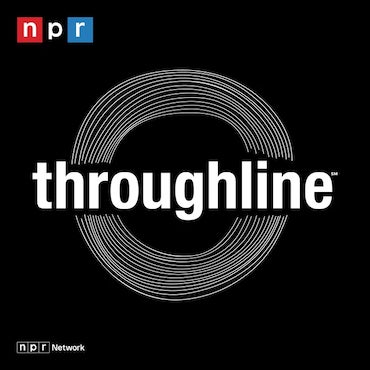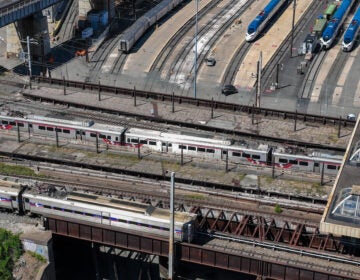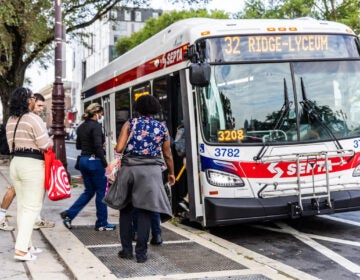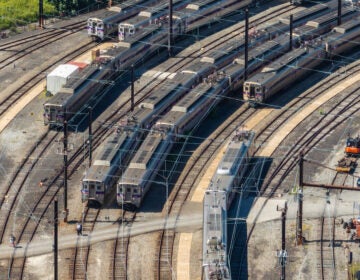Philadelphia Streets Under Pressure: A recap and resource kit

Under pressure.
So describes the state of Philadelphia’s streets, where the competing interests of drivers, cyclists, pedestrians and delivery trucks often boil over into shouting matches and recriminations. As with anything else in the built environment, when we discuss streets under pressure, we’re discussing pressures on different people.
Or, as David Bowie might put it, “Pressure on people / people on the streets.”
Over forty concerned residents braved a torrential downpour to discuss these pressures Tuesday night as part of WHYY’s Speak Easy Forum series. Across the room, attendees were abuzz with the kind of eager frustration born out of seeing a city on the rise, and on the cusp of even greater success, but seemingly held back by what one attendee called “dark wells in the planning and political process.”
PRESSURE! PUSHING DOWN ON ME, PUSHING DOWN ON YOU…
Like so much else in Philadelphia, the city’s streets are a product of its past. When William Penn planned High (now Market) and Broad Street to be 100 feet wide, they were the wider than any London thoroughfare at the time. Most other original streets were set at 50 feet, still impressively broad in the 17th century. Darin Gatti, chief engineer for Philly’s streets department, credited Penn for planning for future uses, not current needs. But what was revolutionary then is small today: Philadelphia’s roads are narrower than most others in U.S. cities.
But that’s not necessarily a bad thing, noted PlanPhilly’s Jon Geeting. While our narrow streets mean more hard choices and tradeoffs among cars, bikes, pedestrians and parking, they are also an asset. Our narrow streets help make Philadelphia such a walkable city and help create a sense of place and community. Narrow streets also make drivers slow down, which means fewer, and less deadly, crashes.
According to Gatti, street designers in the 1960s focused almost exclusively on traffic volumes and speeds – how to get the most people from point A to point B in the shortest time possible – much to the detriment of streets’ other users, like pedestrians and local businesses who rely on foot traffic. In recent years, designers have been focused on finding balance, but that process can feel unfair to drivers long acclimated to the preferential treatment, as though they are being punished so cyclists can gain.
Perhaps nowhere is this felt more keenly than with bicycle lanes. Sarah Clark Stuart of the Bicycle Coalition of Greater Philadelphia advised everyone to “take a deep breath.” Stuart noted that traffic accidents on Pine and Spruce Streets are down 25 percent since bike lanes were installed there – those streets are safer for everyone now, and even if it means that automobile traffic sometimes clogs, she believes that’s a worthy tradeoff.
There is one tradeoff that’s easy, said Greg Krykewycz, Manager of the Delaware Valley Regional Planning Commission’s transit, bicycle and pedestrian planning office: accessibility improvements. Adding an elevator to a subway station is “a lifeline for those in wheelchairs, but it’s also nice for a mom pushing a stroller,” said Krykewycz.
Fellow panelist Thaddeus Robinson, an accessibility activist who sits on SEPTA’s Citizen Advisory Committee, nodded in agreement. Robinson gave SEPTA kudos for leading the nation with the highest number of wheelchair accessible stations, 108 in total. Robinson, who has used a wheelchair since 1993, said that the Americans with Disabilities Act of 1990, along with leadership changes at SEPTA starting in 1996, have made a world of difference to folks like him. Still, challenges remain, with elevators frequently out of service and new vehicles required before some services, like SEPTA’s trolley lines, are accessible. All of those cost money, which is constantly in limited supply, and makes tradeoffs even harder to make.
Despite the challenging tradeoffs facing Philly’s streets, all of the panelists said things have been improving and attitudes changing. It’s fair to say that the panel’s opinion of the streets of Philadelphia is not nearly as depressing as Springsteen’s Streets of Philadelphia.
What planners need more of, said Gatti and Krykewycz, is community feedback. “We rely on you,” said Gatti.
CAN’T WE GIVE OURSELVES ONE MORE CHANCE?
So, how can you lend a hand? The easiest way is letting the city know about the problems you see. Gatti emphasized that the Streets Department relies on resident reports to find potholes. You can call 311 or the pothole hotline (215-686-5560). If you’re more of an online form kind of guy or gal, you can also go here to report all sorts of defects in the roads.
Robinson of SEPTA’s citizen advisory council noted that all of SEPTA’s board meetings are open to the public and have open comment periods. That’s also true of the Philadelphia Parking Authority meetings, the Delaware River Port Authority/PATCO meetings, and DVRPC meetings. All of those meetings have procedures for properly making public comment – usually a sign-up sheet before the meeting begins and the board schedules on available on their websites.
But if you want to know about the projects happening closest to you, your best bet is joining your local Registered Community Organization. RCOs are notified in advance when projects are first proposed. Most RCOs are eager for more members and volunteers, said Geeting.
If you’d like to get involved in your local RCO, you can access the city’s map of neighborhood groups, or read through a list maintained by the City Planning Commission. Gatti said that his department turns to these neighborhood associations for feedback at the planning stages of street developments, as they did with the 41st Street Bridge in Mantua.
The Planning Commission also has periodic open-enrollment periods for new Registered Community Organizations. If you’re interested in starting your own group, you can get more information here. You can also email RCO@Phila.gov, or call 215-683-4685.
Finally, City Council has a lot of power over transportation projects in this town. One of the most effective ways of ensuring your voice is heard is to make sure your district council person hears it. You can find your district council person using the City Commissioners website. But learning your council representative’s name is just the first step. To be really effective, he or she should know your name. Don’t be shy: If you talk (in a calm, sane manner), they will listen. They might not do what you want, but they’ll listen.
WHY CAN’T WE GIVE LOVE THAT ONE MORE CHANCE?
If you care about the rebalancing of our cramped streets or how transportation infrastructure can influence and inspire development, share your perspective. PlanPhilly’s Eyes on the Street blog and NewsWorks’ Speak Easy blog both publish commentary from civic leaders and neighborhood folks on a wide range of topics. If you’ve got something to say, you can email Ashley Hahn at Eyes on the Street (ahahn@planphilly.com) or Eric Walter at Speak Easy (ewalter@whyy.org).
You can also visit Speak Easy right now to read commentary from Tuesday night’s panelists:
· Thaddeus Robinson – SEPTA Citizen’s Advisory Council
· Darin L. Gatti – Philadelphia Streets Department
· Sarah Stuart Clark – Bicycle Coalition of Greater Philadelphia
WHYY is your source for fact-based, in-depth journalism and information. As a nonprofit organization, we rely on financial support from readers like you. Please give today.






